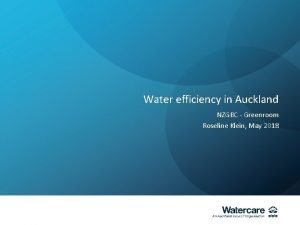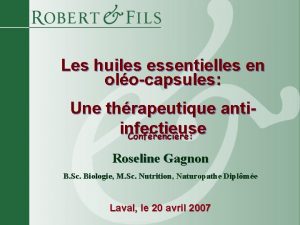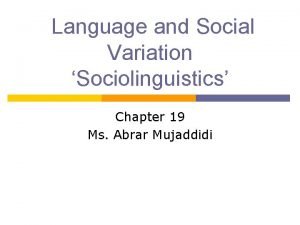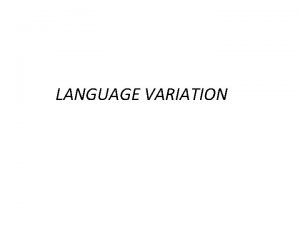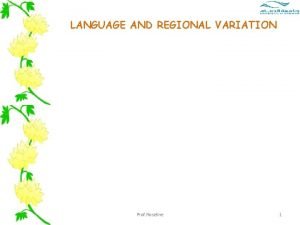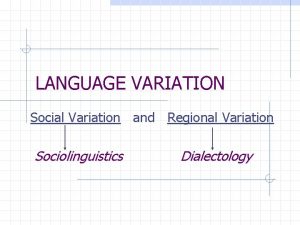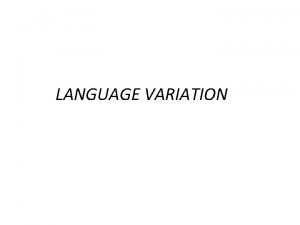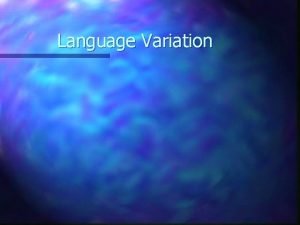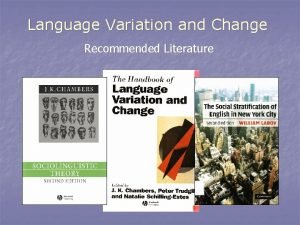Language and Social Variation Prof Roseline 1 STANDARD








- Slides: 8

Language and Social Variation Prof. Roseline 1

STANDARD LANGUAGE: the variety of a language treated as the official language and used in public broadcasting, publishing and education üThis is actually an idealized variety, because it has no specific region. üIt is the variety associated with administrative, commercial and educational centers, regardless of region. üStandard English - found in printed English in newspapers and books, is widely used in the mass media and is taught in most schools. üIt is the variety we normally try to teach to those who want to learn English as a second or foreign language. üIt is clearly associated with education and broadcasting in public contexts and is more easily described in terms of the written language (i. e. vocabulary, spelling, grammar) than the spoken language. Prof. Roseline 2

ACCENT & DIALECT Accent: aspects of pronunciation that identify where a speaker is from, in contrast to dialect “ACCENT” is restricted to the description of aspects of pronunciation that identify where an individual speaker is from, regionally or socially DIALECT: aspects of the grammar, vocabulary and pronunciation of a variety of a language, in contrast to accent - is used to describe features of grammar and vocabulary as well as aspects of pronunciation DIALECTOLOGY The Study of Dialects This is one of the criteria used in the study of dialects, or dialectology, to distinguish between two different dialects of the same language (whose speakers can usually understand each other) and two different languages (whose speakers can’t usually understand each other). Prof. Roseline 3

REGIONAL DIALECTS The existence of different regional dialects is widely recognized and often the source of some humor for those living in different region ISOGLOSSES & DIALECT BOUNDARIES ISOGLOSS: a line on a map separating two areas in which a particular linguistic feature is significantly different, used in the study of dialect Dialect Boundary: a line representing a set of isoglosses, used to separate one dialect area from another THE DIALECT CONTINUUM Dialect Continuum: the gradual merging of one regional variety of a language into another BILINGUALISM & DIGLOSSIA situation where there is a “high” or special variety of a language used in formal situations (e. g. the state of having two Classical Arabic), and a “low” languages variety used locally and informally (e. g. Lebanese Arabic) Prof. Roseline 4

PIDGINS & CREOLES Papua New Guinea, a lot of official business is conducted in Tok Pisin. This language is now used by over a million people, but it began many years earlier as a kind of “contact” language called a pidgin. A variety of a language that developed for a practical purpose such as trade, but which has no native speakers, in contrast to a Creole A pidgin is a variety of a language that developed for some practical purpose, such as trading, among groups of people who had a lot of contact, but who did not know each other’s languages. The origin of the term “pidgin” is thought to be from a Chinese version of the English word “business. ” There are several English pidgins still used today. They are characterized by an absence of any complex grammatical morphology and a somewhat limited vocabulary. CREOLES Between six and twelve million people still using pidgin languages and between ten and seventeen million using descendants from pidgins called “creoles. ” When a pidgin develops beyond its role as a trade or contact language and becomes the first language of a social community, it is described as a Creole. Prof. Roseline 5

CREOLES Tok Pisin is now a creole. Although still locally referred to as “Pidgin, ” the language spoken by a large number of people in Hawai’i is also a creole, technically known as Hawai’i Creole English. A creole initially develops as the first language of children growing up in a pidgin-using community and becomes more complex as it serves more communicative purposes. Unlike pidgins, creoles have large numbers of native speakers and are not restricted at all in their uses. A French Creole is spoken by the majority of the population in Haiti and English creoles are used in Jamaica and Sierra Leone. The separate vocabulary elements of a pidgin can become grammatical elements in a Creole. Prof. Roseline 6

THE POST-CREOLE CONTINUUM Just as there was development from a pidgin to a creole, known as creolization, there is now often a retreat from the use of the Creole by those who have greater contact with a standard variety of the language. The process of development from a pidgin to a Creole Where education and greater social prestige are associated with a “higher” variety (e. g. British English in Jamaica), a number of speakers will tend to use fewer Creole forms and structures. The process whereby a Creole is used with fewer distinct Creole features as it becomes more like a standard variety This process, known as decreolization, leads at one extreme to a variety that is closer to the external standard model and leaves, at the other extreme, a basic variety with more local Creole features. Between these two extremes may be a range of slightly different varieties, some with many and some with fewer Creole features. This range of varieties, evolving after (= “post”) the Creole has come into existence, is called the post-creole continuum. Prof. Roseline the range of varieties that evolves in communities where a creole is spoken, usually as a result of decreolization 7

THANK YOU Prof. Roseline 8
